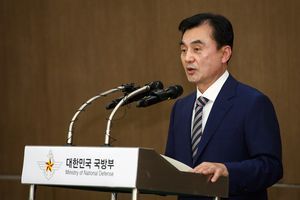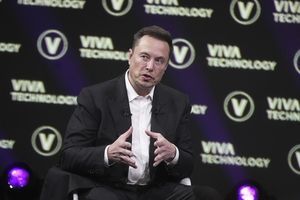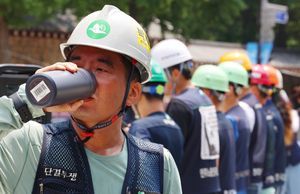Trump’s Tough Talk: Steep Tariffs and Arms Sales to Ukraine Set to Shake Up Russia
koreaherald Views
 WASHINGTON (AP) — President Donald Trump on Monday threatened Russia with steep tariffs and announced a revitalized pipeline for American weapons to reach Ukraine, hardening his stance toward Moscow after months of frustration over failed peace negotiations.
WASHINGTON (AP) — President Donald Trump on Monday threatened Russia with steep tariffs and announced a revitalized pipeline for American weapons to reach Ukraine, hardening his stance toward Moscow after months of frustration over failed peace negotiations.
This shift in approach from the Republican president, who initially promised a swift resolution to the conflict initiated by Russian President Vladimir Putin’s invasion of Ukraine three years ago, is becoming increasingly evident. Trump, who once directed his criticism at Ukrainian President Volodymyr Zelenskyy for an alleged unwillingness to compromise, has recently begun expressing growing irritation toward Putin.
“My conversations with him are very pleasant, and then the missiles go off at night,” Trump remarked, adding with frustration, “it just keeps going on and on and on.”
The President declared his intention to impose “severe tariffs” unless a peace deal is reached within 50 days. While details on implementation were scarce, he described them as secondary tariffs aimed at Russia’s trading partners to isolate Moscow economically.
Furthermore, Trump announced that European allies would purchase “billions and billions” of dollars worth of U.S. military equipment to be transferred to Ukraine, replenishing the embattled nation’s weapon supplies. This announcement was made in the Oval Office alongside NATO Secretary-General Mark Rutte.
The plan includes Patriot air defense systems, a critical asset for Ukraine in its defense against Russian drones and missiles.
Recent doubts about Trump’s commitment to supplying Ukraine arose when the Pentagon paused shipments due to concerns over depleting U.S. stockpiles.
Rutte listed Germany, Finland, Canada, Norway, Sweden, the United Kingdom, and Denmark among the countries that would purchase equipment for Ukraine. He emphasized the urgency, suggesting that some weapons would be rushed to Ukraine and later replaced with U.S. purchases.
Later Monday, Zelenskyy reported a phone conversation with Trump, discussing strategies to enhance protection against Russian attacks and strengthen Ukraine’s position.
Zelenskyy added that Trump had agreed to more frequent phone calls and future coordination of their efforts.
Trump has long boasted of his amicable relationship with Putin, consistently claiming that Russia was more willing than Ukraine to reach a peace deal. He even accused Zelenskyy of prolonging the war, labeling him a “dictator without elections.”
However, Russia’s relentless attacks on Ukrainian civilians have tested Trump’s patience. In April, Trump urged Putin to “STOP!” the deadly assaults on Kyiv, and the following month, he declared on social media that the Russian leader “has gone absolutely CRAZY!”
While Rutte was in Washington, Trump’s special envoy to Ukraine and Russia, retired Lt. Gen. Keith Kellogg, met with Zelenskyy in Kyiv.
Zelenskyy described his meeting with Kellogg as “productive,” covering topics such as bolstering Ukrainian air defenses, joint arms production, U.S. weapons purchases in conjunction with European countries, and the potential for stricter international sanctions on the Kremlin.
“We’re counting on U.S. leadership, as it’s clear Moscow won’t back down unless its ambitions are forcefully checked,” Zelenskyy stated on Telegram.
Russia has bombarded Ukrainian cities, including Kyiv, with hundreds of drones and cruise and ballistic missiles, overwhelming Ukraine’s air defenses. June saw the highest monthly civilian casualties in three years, with 232 killed and 1,343 wounded, according to the UN human rights mission in Ukraine.
Simultaneously, Russia’s larger army is renewing efforts to push back Ukrainian defenders along the 1,000-kilometer front line.
Trump confirmed that the U.S. is sending additional Patriot air defense missiles to Ukraine, with the European Union set to reimburse the U.S. for the “highly sophisticated” weaponry.
Konstantin Kosachev, a senior Russian lawmaker, criticized Trump’s plan, claiming it benefits “only the U.S. military-industrial complex.” Meanwhile, Germany has offered to finance two Patriot systems, according to government spokesperson Stefan Kornelius, having already supplied three of its own to Ukraine.
German Defense Minister Boris Pistorius was en route to Washington on Monday to meet with Defense Secretary Pete Hegseth.
“We’re committed to taking on greater responsibility for Europe’s defense and deterrence, while acknowledging the indispensable role of the United States in our collective security,” Pistorius told reporters.
Senator Lindsey Graham, a close Trump ally, stated on Sunday that the conflict is approaching a critical juncture as Trump shows increasing interest in supporting Ukraine against Russia’s full-scale invasion.
Despite Trump’s previous dismissal of aid to Ukraine as a waste of taxpayer money, Graham told CBS’ “Face the Nation” that “you’ll see weapons flowing at a record level.” He added, “One of Putin’s biggest miscalculations was trying to manipulate Trump.
In the coming weeks, expect a major push to bring Putin to the negotiating table.” Kirill Dmitriev, Putin’s international investment envoy who participated in talks with U.S. officials in Saudi Arabia in February, dismissed attempts to drive a wedge between Moscow and Washington.
“Constructive dialogue between Russia and the U.S. is more effective than futile pressure tactics,” Dmitriev posted on Telegram. “This dialogue will persist, despite enormous efforts to derail it.” While proposing new tariffs on Russia, Trump expressed uncertainty about additional bipartisan legislation to punish the country further.
“I’m not sure it’s necessary,” he said. “It could be very useful. We’ll have to see.” The legislation increases sanctions and imposes 500% tariffs on products from countries purchasing Russian oil, gas, and other exports. Trump suggested unilaterally implementing 100% tariffs.
“I use trade as a tool for many things,” he stated. “It’s particularly effective in ending wars.” Since the EU banned Russian oil on December 5, 2022, China has purchased 47% of Russia’s crude oil exports, followed by India at 38%. Turkey and the EU each account for 6%, according to the Center for Research on Energy and Clean Air, a Finnish nonprofit tracking the energy industry.
Zongyuan Zoe Liu, a senior fellow in China studies at the Council on Foreign Relations, doubted that tariffs would significantly impact the war’s trajectory.
“Oil is fungible, and Russia has developed a nimble shadow fleet,” Liu noted. “Enforcement would be challenging.” However, the tariffs could still have far-reaching effects, depending on their implementation.
Adding a 100% tariff on China, on top of existing import taxes, would essentially halt trade between the United States and China, the world’s two largest economies.










Most Commented